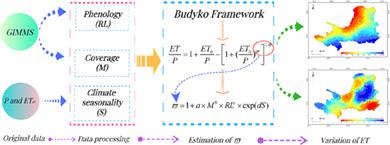当前位置:
X-MOL 学术
›
Hydrol. Process.
›
论文详情
Our official English website, www.x-mol.net, welcomes your
feedback! (Note: you will need to create a separate account there.)
Modelling interannual variations in catchment evapotranspiration considering vegetation and climate seasonality using the Budyko framework
Hydrological Processes ( IF 2.8 ) Pub Date : 2021-03-08 , DOI: 10.1002/hyp.14118 Yaqin Wang 1, 2, 3 , Yi Luo 1, 2 , Muhammad Shafeeque 1, 2 , Meilin Zhou 1, 2 , Hongyu Li 1, 2
Hydrological Processes ( IF 2.8 ) Pub Date : 2021-03-08 , DOI: 10.1002/hyp.14118 Yaqin Wang 1, 2, 3 , Yi Luo 1, 2 , Muhammad Shafeeque 1, 2 , Meilin Zhou 1, 2 , Hongyu Li 1, 2
Affiliation

|
The Budyko framework is an efficient tool for investigating catchment water balance, focusing on the effects of seasonal changes in climate (S) and vegetation cover (M) on catchment evapotranspiration (ET). However, the effects of vegetation seasonality on ET remain largely unknown. The present study explored these effects by modelling interannual variations in ET considering vegetation and climate seasonality using the Budyko framework. Reconstructed 15‐day GIMMS NDVI3g timeseries data from 1982 to 2015 were used to estimate M and extract the relative duration of the vegetation growing season (GL) in the Yellow River Basin (YRB). To characterize S, seasonal variations in precipitation and potential ET were extracted using a Gaussian algorithm. Analysis of the observed datasets for 19 catchments revealed that interannual variation in the catchment parameter ϖ (in Fuh's equation) was significantly and positively correlated with M and GL. Conversely, ϖ was significantly but negatively correlated with S. Furthermore, stepwise linear regression was used to calibrate the empirical formula of ϖ for these three dimensionless parameters. Following validation, based on observations in the remaining 11 catchments, ϖ was integrated into Fuh's equation to accurately estimate annual ET. Over 79% subcatchments showed an upward trend (0.9 mm yr−1), whereas fewer than 21% subcatchments showed a downward trend (−0.5 mm yr−1) across YRB. In the central region of the middle reach, ET increased with increased M, prolonged GL, and decreased S, whereas in the source region of YRB, ET decreased with decreased M and shortened GL. Our study provides an alternative method to estimate interannual ET in ungauged catchments and offers a novel perspective to investigate hydrological responses to vegetation and climate seasonality in the long‐term.
中文翻译:

使用Budyko框架模拟考虑植被和气候季节性的流域蒸散量的年际变化
Budyko框架是研究流域水平衡的有效工具,重点关注气候(S)和植被覆盖率(M)的季节性变化对流域蒸散量(ET)的影响。但是,植被季节性变化对ET的影响仍然未知。本研究通过使用Budyko框架考虑植被和气候季节的变化对ET的年际变化进行建模,探索了这些影响。从1982年到2015年重建的15天GIMMS NDVI 3g时间序列数据用于估算M并提取植被生长期的相对持续时间(GL)在黄河流域(YRB)。为了表征S,使用高斯算法提取了降水和潜在ET的季节性变化。对19个流域的观测数据集的分析表明,流域参数ϖ(在Fuh方程中)的年际变化与M和GL显着正相关。相反,ϖ与S显着相关,但呈负相关。此外,使用逐步线性回归来校准这三个无量纲参数的ϖ的经验公式。验证之后,根据对其余11个流域的观察,ϖ被集成到Fuh方程中,以准确估算年度ET。在整个YRB地区,超过79%的子汇水面积呈现上升趋势(0.9 mm yr -1),而少于21%的子汇水面积呈现下降趋势(-0.5 mm yr -1)。在中游的中部,ET随着M的增加,GL的延长和S的减少而增加,而在YRB的源区,ET随着M的减少和GL的缩短而减少。我们的研究提供了一种估算年际ET的替代方法 在未开垦的集水区,并为研究长期对植被和气候季节性的水文响应提供了新颖的视角。
更新日期:2021-04-20
中文翻译:

使用Budyko框架模拟考虑植被和气候季节性的流域蒸散量的年际变化
Budyko框架是研究流域水平衡的有效工具,重点关注气候(S)和植被覆盖率(M)的季节性变化对流域蒸散量(ET)的影响。但是,植被季节性变化对ET的影响仍然未知。本研究通过使用Budyko框架考虑植被和气候季节的变化对ET的年际变化进行建模,探索了这些影响。从1982年到2015年重建的15天GIMMS NDVI 3g时间序列数据用于估算M并提取植被生长期的相对持续时间(GL)在黄河流域(YRB)。为了表征S,使用高斯算法提取了降水和潜在ET的季节性变化。对19个流域的观测数据集的分析表明,流域参数ϖ(在Fuh方程中)的年际变化与M和GL显着正相关。相反,ϖ与S显着相关,但呈负相关。此外,使用逐步线性回归来校准这三个无量纲参数的ϖ的经验公式。验证之后,根据对其余11个流域的观察,ϖ被集成到Fuh方程中,以准确估算年度ET。在整个YRB地区,超过79%的子汇水面积呈现上升趋势(0.9 mm yr -1),而少于21%的子汇水面积呈现下降趋势(-0.5 mm yr -1)。在中游的中部,ET随着M的增加,GL的延长和S的减少而增加,而在YRB的源区,ET随着M的减少和GL的缩短而减少。我们的研究提供了一种估算年际ET的替代方法 在未开垦的集水区,并为研究长期对植被和气候季节性的水文响应提供了新颖的视角。











































 京公网安备 11010802027423号
京公网安备 11010802027423号